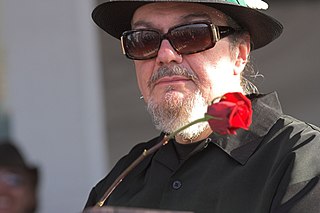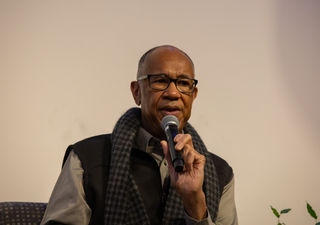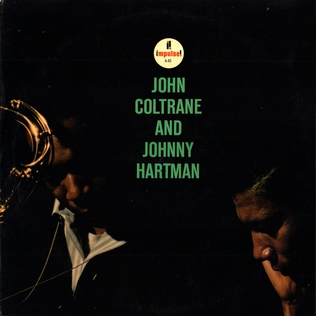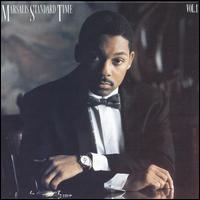
Earth, Wind & Fire is an American band formed in Chicago, Illinois in 1969. Their music spans multiple genres, including jazz, R&B, soul, funk, disco, pop, Latin and Afro-pop. They are among the best-selling bands of all time, with sales of over 90 million records worldwide.
The 25th Annual Grammy Awards were held on February 23, 1983, at Shrine Auditorium, Los Angeles. They recognized accomplishments by musicians from the previous year.

Malcolm John Rebennack, Jr., better known by his stage name Dr. John, was an American singer, songwriter and pianist. His music combined New Orleans blues, jazz, R&B, soul and funk.

Grover Washington Jr. was an American jazz-funk and soul-jazz saxophonist and Grammy Award winner. Along with Wes Montgomery and George Benson, he is considered by many to be one of the founders and legends of the smooth jazz genre. He wrote some of his material and later became an arranger and producer.

Modern Sounds in Country and Western Music is a studio album by American singer and pianist Ray Charles. It was recorded in February 1962 at Capitol Studios in New York City and United Western Recorders in Hollywood, and released in April of that year by ABC-Paramount Records.

Maurice White was an American musician, best known as the founder, leader, main songwriter and chief producer of the band Earth, Wind & Fire, also serving as the band's co-lead singer with Philip Bailey.

Montgomery Bernard "Monty" Alexander OJ CD is a Jamaican American jazz pianist. His playing has a Caribbean influence and bright swinging feeling, with a strong vocabulary of bebop jazz and blues rooted melodies. He was influenced by Louis Armstrong, Duke Ellington, Erroll Garner, Nat King Cole, Oscar Peterson, Ahmad Jamal, Les McCann, and Frank Sinatra. Alexander also sings and plays the melodica. He is known for his surprising musical twists, bright rhythmic sense, and intense dramatic musical climaxes. His recording career has covered many of the well-known American songbook standards, jazz standards, pop hits, and Jamaican songs from his original homeland. Alexander has resided in New York City for many years and performs frequently throughout the world at jazz festivals and clubs.

Philip James Bailey is an American singer, songwriter and percussionist, best known as an early member and one of the two lead singers of the band Earth, Wind & Fire. Noted for his four-octave vocal range and distinctive falsetto register, Bailey was inducted into the Rock and Roll Hall of Fame and the Vocal Group Hall of Fame as a member of Earth, Wind & Fire. Bailey was also inducted into the Songwriters Hall of Fame for his work with the band.

David "Fathead" Newman was an American jazz and rhythm-and-blues saxophonist, who made numerous recordings as a session musician and leader, but is best known for his work as a sideman on seminal 1950s and early 1960s recordings by Ray Charles.

The Count Basie Orchestra is a 16- to 18-piece big band, one of the most prominent jazz performing groups of the swing era, founded by Count Basie in 1935 and recording regularly from 1936. Despite a brief disbandment at the beginning of the 1950s, the band survived long past the big band era itself and the death of Basie in 1984. It continues under the direction of trumpeter Scotty Barnhart.

John Lee Clayton Jr. is an American jazz musician, classical double bassist, arranger, and composer.

Christmas Songs is the eighth studio album by Canadian singer Diana Krall, performed with The Clayton/Hamilton Jazz Orchestra. It was released on October 26, 2005, by Verve Records. This is Krall's first full-length album of Christmas songs, and her first studio album with a big band. The album was released on vinyl for the first time on October 14, 2016.

Diane Joan Schuur, nicknamed "Deedles", is an American jazz singer and pianist. As of 2015, Schuur had released 23 albums, and had extended her jazz repertoire to include essences of Latin, gospel, pop and country music. Her most successful album is Diane Schuur & the Count Basie Orchestra, which remained number one on the Billboard Jazz Charts for 33 weeks. She won Grammy Awards for best female jazz vocal performance in both 1986 and 1987 and has had three other Grammy nominations.

"Call It Stormy Monday (But Tuesday Is Just as Bad)" (commonly referred to as "Stormy Monday") is a song written and recorded by American blues electric guitar pioneer T-Bone Walker. It is a slow twelve-bar blues performed in the West Coast blues-style that features Walker's smooth, plaintive vocal and distinctive guitar work. As well as becoming a record chart hit in 1948, it inspired B.B. King and others to take up the electric guitar. "Stormy Monday" became Walker's best-known and most-recorded song.

John Coltrane and Johnny Hartman is a studio album by John Coltrane and Johnny Hartman which was released by Impulse! Records in July or August 1963. It was inducted into the Grammy Hall of Fame in 2013.
"Peter Gunn" is the theme music composed by Henry Mancini for the television show of the same name. The song was the opening track on the original soundtrack album, The Music from Peter Gunn, released by RCA Victor in 1959. Mancini won an Emmy Award and two Grammys for Album of the Year and Best Arrangement. In 2005, the song was inducted into the Grammy Hall of Fame.

Catherine Russell is an American jazz and blues singer. She is best known for her 2016 album Harlem on My Mind and for touring with David Bowie and Steely Dan.

"Here We Go Again" is a country music standard written by Don Lanier and Red Steagall that first became notable as a rhythm and blues single by Ray Charles from his 1967 album Ray Charles Invites You to Listen. It was produced by Joe Adams for ABC Records/Tangerine Records. To date, this version of the song has been the biggest commercial success, spending twelve consecutive weeks on the US Billboard Hot 100 chart, peaking at number 15.

Marsalis Standard Time, Vol. 1 is an album by jazz trumpeter Wynton Marsalis that was released in 1987. It won the Grammy Award for Best Jazz Instrumental Performance, Group in 1988.

Now and Then is an album by the American musician Ernestine Anderson, released in 1993. It was her first album for Quincy Jones's Qwest Records; Jones had been her high school classmate. The album was nominated for a Grammy Award for "Best Jazz Vocal Performance, Female". Now and Then peaked in the top 10 of Billboard's Jazz Albums chart. Anderson supported it with a North American tour.


















